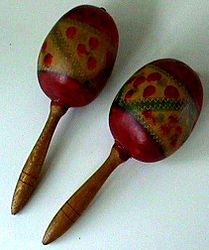1. THE MUSIC IN AFRICA
TREASURE HUNT!
1. INTRODUCTION
It is a product of associations (hunters, warriors and secret societies) and it also can serve as an aid to work. (source: https://blogs.qub.ac.uk/johea02/2012/11/27/make-a-list-of-characteristics-of-african-music/).
Let´s learn more about Adfrican Music!
2. QUESTIONS
LOOK AT THE FIRST RESOURCE FOR THIS QUESTION
1) What is African Music?
LOOK AT THE SECOND RESOURCE FOR THIS QUESTIONS
2) What are the typical instruments in Africa?
3) Choose two of the typical instruments you have already learnt about and draw them in your paper.
4) Describe the instruments you have chosen.
LOOK AT THE THIRD LINK FOR THIS QUESTIONS
5) Why is it so important the dance for African societies?
6) What are the typical dresses for African dance like?
Now answer THE GREAT QUESTION
3. RESOURCES
4. THE GREAT QUESTION
Listen to the video "African mask dances and rituals" that you have below and write the differences you can see and hear between African and European Music.
ASSESSMENT
You will get as many points as questions you get right. The more information you get the better it will be your assessment.
CREDITS
This treasure hunt has been created by Daniel Al Ramahi González.
African mask dances and rituals
The African mask is believed to represent a spirit and it is also believed that the spirit possesses the dancer as they wear the mask.
source: youtube
2. PERCUSSION INSTRUMENTS
Percussion instruments are those instruments that produce sound when we strike, shake or scrape them.
We STRIKE a djembé.
We SHAKE the maracas.

We SCRAPE the guiro
we divide percussion instruments in two groups:
- PITCHED PERCUSSION INSTRUMENTS: Are those instruments that can produce different musical notes.
- UNPITCHED PERCUSSION INSTRUMENTS: Are those instruments that can not produce different musical notes.
3. SINGING
Let´s sing together!
Siyahamba (Written by Andries Van Tonder) is a South African hymn The title means "We Are Marching" .
Siyahamba - Mwamba Children's Choir
source: youtube
Siyahamba- Karaoke
source: youtube
Si mama ka
4. BUILDING AN INSTRUMENT FROM AFRICA
In this unit, you have learnt about some traditional African instruments. One of them, the shekere, is a handmade (*1)rattle. It consists of a (*2)calabash, covered on the outside with a (*3)net of seeds, (*4)shells, or any available material. Although its origins are West African, today it is found in the Americas and Caribbean as well.
(source: https://www.ibiblio.org/musicians/botsford/educators/shekere/)

Translated key words
(*1)rattle= Maraca.
(*2)calabash= calabaza.
(*3)net of seeds = red con semillas.
(*4)shells= conchas.
- Now it is time for you to build your own shekere. You will need the following materials:
- A plastic bottle.
HERE I LET YOU SOME WEBS AND IDEAS FOR YOUR SHEKERE:
http://www.ensaimadamalabar.com/shekere.htm
source:http://www.ensaimadamalabar.com/shekere.htm

Source: https://coleenriquealonso.wordpress.com/2015/05/10/construimos-instrumentos-musicales-con-material-reciclable/












